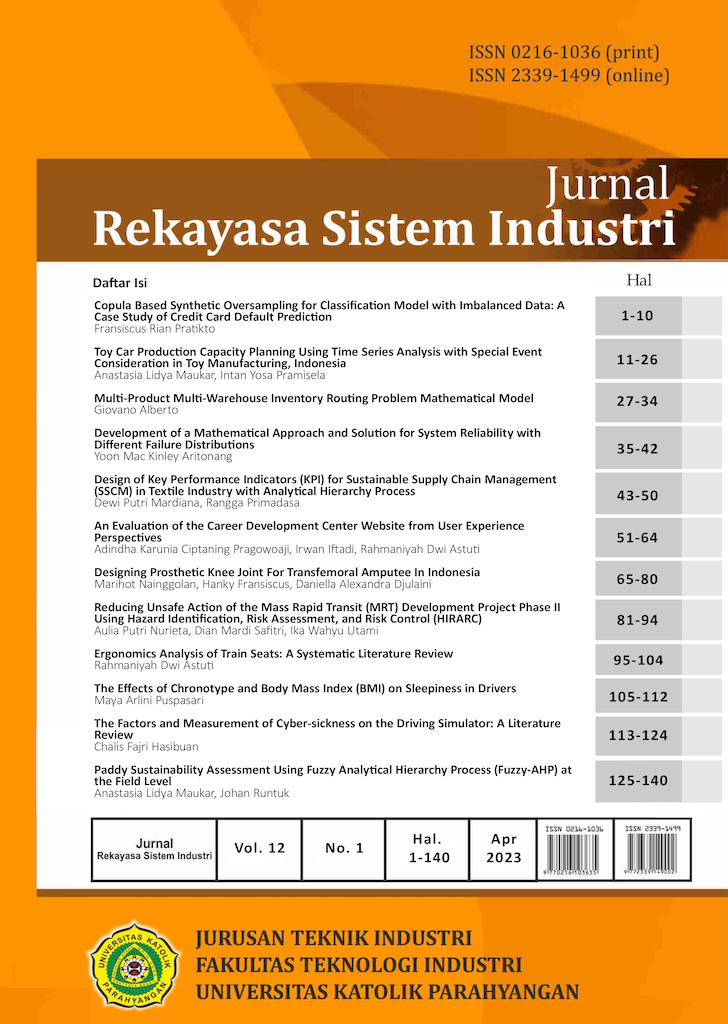An Evaluation of the Career Development Center Website from User Experience Perspectives
DOI:
https://doi.org/10.26593/jrsi.v12i1.5961.51-64Keywords:
career development center, interview, UEQ, user experience, website evaluationAbstract
With the launch of the career development center (CDC) website in the digital era, XYZ university in Indonesia takes the initiative to serve as a liaison between students and companies in need of new talent. The website is intended to distribute job market and career development information to students and graduates. However, no evaluation directly involving students and graduates was conducted during the development process. As a result, this study aims to assess the level of user experience to comprehend users' perceptions of the current CDC website. The User Experience Questionnaire (UEQ) is used in this study to assess students' and alumni's perceptions as one entity. In addition, semi-structured interviews are conducted to better understand users' pain points. From the measurement with UEQ, the website's attractiveness got a positive impression from users with 0,99 points. The pragmatic quality aspect also makes a positive impression. This aspect consists of three variables: perspicuity (1,21 points), efficiency (0,83 points), and dependability (1,12 points). In contrast, the stimulation (0,74 points) and novelty (-0,37 points) variables on the hedonic quality aspect leave the user with a neutral impression. Based on interviews, users believe that the job vacancy information available on the CDC website still needs to be improved in quantity and variety. Users also need help finding the novelty aspect in terms of website appearance. This study successfully incorporated UEQ into the evaluation stage of a university's career development center website, which had never been done in previous research.
References
Barnum, C. M. (2021). Usability Testing Essentials : Ready, Set-- Test! (2nd ed.). Cambridge: Elsevier.
Díaz-Oreiro, I., López, G., Quesada, L., & Guerrero, L. A. (2019). Standardized Questionnaires for User Experience Evaluation: A Systematic Literature Review. Proceedings, 31(14), 1–12. https://doi.org/10.3390/proceedings2019031014
Garrett, J. J. (2011). The Elements of User Experience : User-Centered Design for The Web and Beyond (2nd ed., Vol. 2). Berkeley: New Riders.
Guest, G., Bunce, A., & Johnson, L. (2016). How Many Interviews Are Enough?: An Experiment with Data Saturation and Variability. Field Methods, 18(1), 59–82. https://doi.org/10.1177/1525822X05279903
Hasan, L. (2021). Examining User Experience of Moodle e-Learning System. International Journal of Advanced Computer Science and Applications, 12(11), 358–366. https://doi.org/10.14569/IJACSA.2021.0121141
Hassenzahl, M. (2001). The Effect of Perceived Hedonic Quality on Product Appealingness. International Journal of Human-Computer Interaction, 13(4), 481–499. https://doi.org/10.1207/S15327590IJHC1304_07
Hussain, J., Khan, W. A., Hur, T., Bilal, H. S. M., Bang, J., Ul Hassan, A., Afzal, M., & Lee, S. (2018). A Multimodal Deep Log-Based User Experience (UX) Platform for UX Evaluation. Sensors (Switzerland), 18(5). https://doi.org/10.3390/s18051622
Joo, H. (2017). A Study on Understanding of UI and UX, and Understanding of Design According to User Interface Change. In International Journal of Applied Engineering Research, 12(20), 9931-9935.
Jusoh, S., Almajali, S., & Abualbasal, A. (2019). A Study of User Experience for E-Learning Using Interactive Online Technologies. Journal of Theoretical and Applied Information Technology, 97(15), 4036–4047.
Laugwitz, B., Held, T., & Schrepp, M. (2008). Construction and Evaluation of a User Experience Questionnaire. Lecture Notes in Computer Science (Including Subseries Lecture Notes in Artificial Intelligence and Lecture Notes in Bioinformatics), 5298 LNCS, 63–76. https://doi.org/10.1007/978-3-540-89350-9_6
Martin, B., & Hanington, B. (2012). Universal Methods of Design : 100 Ways to Research Complex Problems, Develop Innovative Ideas, and Design Effective Solutions. Beverly: Rockport Publishers.
Nielsen, J., & Landauer, T. K. (1993). Mathematical Model of The Finding of Usability Problems. Conference on Human Factors in Computing Systems, 206–213. https://doi.org/10.1145/169059.169166
Portigal, S. (2013). Interviewing Users : How to Uncover Compelling Insights. Brooklyn: Rosenfeld Media.
Rauschenberger, M., Schrepp, M., Perez-Cota, M., Olschner, S., & Thomaschewski, J. (2013). Efficient Measurement of the User Experience of Interactive Products. How to use the User Experience Questionnaire (UEQ). Example: Spanish Language Version. International Journal of Interactive Multimedia and Artificial Intelligence, 2(1), 39-45. https://doi.org/10.9781/IJIMAI.2013.215
Remy, C., Harboe, G., Frich, J., Biskjaer, M. M., & Dalsgaard, P. (2021). Challenges and Opportunities in the Design of Digital Distributed Affinity Diagramming Tools. ACM International Conference Proceeding Series. https://doi.org/10.1145/3452853.3452871
Rohles, B., Backes, S., Fischbach, A., Amadieu, F., & Koenig, V. (2022). Creating Positive Learning Experiences with Technology: A Field Study on The Effects of User Experience for Digital Concept Mapping. Heliyon, 8(4), 1-21. https://doi.org/10.1016/J.HELIYON.2022.E09246
Sabukunze, I. D., & Arakaza, A. (2021). User Experience Analysis on Mobile Application Design Using User Experience Questionnaire. Indonesian Journal of Information Systems, 4(1), 15–26. https://doi.org/10.24002/IJIS.V4I1.4646
Sagirani, T., Hariadi, B., Sunarto, M. J. D., Amelia, T., & Lemantara, J. (2021). Evaluation of User Experience on Using the “MoLearn” Application in Learning Activities of High School Students. International Journal on Advanced Science, Engineering and Information Technology, 11(6), 2422–2427. https://doi.org/10.18517/IJASEIT.11.6.12454
Schrepp, M. (2019). User Experience Questionnaire Handbook (8th ed.), [Online], Diakses dari: www.ueq-online.org [2022, 10 March].
Schrepp, M., Hinderks, A., & Thomaschewski, J. (2017). Construction of a Benchmark for the User Experience Questionnaire (UEQ). International Journal of Interactive Multimedia and Artificial Intelligence, 4, 4–40. https://doi.org/10.9781/ijimai.2017.445
Schrepp, M., Pérez Cota, M., Gonçalves, R., Hinderks, A., & Thomaschewski, J. (2017). Adaption of User Experience Questionnaires for Different User Groups. Universal Access in the Information Society, 16(3), 629–640. https://doi.org/10.1007/S10209-016-0485-9
Tullis, T., & Albert, B. (2013). Measuring the User Experience: Collecting, Analyzing, and Presenting Usability Metrics (2nd ed.). Waltham: Elsevier.
Virzi, R. A. (2016). Refining the Test Phase of Usability Evaluation: How Many Subjects Is Enough?: Https://Doi.Org/10.1177/001872089203400407, 34(4), 457–468. https://doi.org/10.1177/001872089203400407
Wijaya, I. N. S. W., Santika, P. P., Iswara, I. B. A. I., & Arsana, I. N. A. A. (2021). Analisis dan Evaluasi Pengalaman Pengguna PaTik Bali dengan Metode User Experience Questionnaire (UEQ). Jurnal Teknologi Informasi Dan Ilmu Komputer, 8(2), 217–226. https://doi.org/10.25126/jtiik.202182763
Yablonski, J. (2020). Laws of UX Using Psychology to Design Better Products & Services (1st ed.). Sebastopol: O’Reilly Media.

